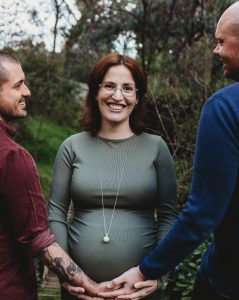
.
Episode 61 – Education – How did you get pregnant as a surrogate?
In case you’re wondering, it’s never by having intercourse with the Intended Father 😉.
.
This page is part of a series of surrogacy education episodes from Anna. On the main podcast page you will find recent episodes and links to other categories: surrogates, gay dads, straight mums and guest / theme.
Join Anna McKie in conversation with surrogates and parents who have navigated Australian altruistic surrogacy. Anna is a gestational surrogate, high school Math teacher and surrogacy educator working with Surrogacy Australia and running SASS (Surrogacy Australia’s Support Service).
The other episodes of the podcast were recorded as part of our free, fortnightly webinar series. If you would like to attend one, check out our dates and registration links. The recordings can also be found on our YouTube channel so you can see the photos that are described in the recordings.
Follow us on Instagram, Facebook and YouTube.
00:06
How do you get pregnant as a surrogate? In case you’re wondering, it’s never by having intercourse with the intended father. This question is a classic for new surrogates and also for new IPs, we abbreviate that to intended parents. Most surrogates get pregnant through an embryo transfer, an IVF process through a fertility clinic. An embryo is made from an egg, fertilized with sperm, and grown in the lab for about five days and then stored in the freezer.
00:33
The egg for the embryo is usually provided by the intended mother if they’re a straight couple or a single woman, or an egg donor if the surrogate is carrying for a same-sex male couple or single man. But sometimes the intended mother needs an egg donor as well as a surrogate. That was the case for me in two of the three times I was an egg donor. The embryo, that egg that’s been fertilized with sperm, is transferred into the surrogate’s body about five days after her body has ovulated with her own egg.
01:00
She would have blood tests every couple of days after her period so they can pinpoint when ovulation is due to occur. Now, I’m never sure if I should point out this next part because I don’t want to strike fear into anyone. But since the surrogate’s body is usually still producing its own eggs, it does mean she can fall pregnant naturally in that month too. Now, trust me, surrogates do not want that to happen. We have finished our families and we don’t want any more keeper children.
01:29
Surrogacy is all about trust though, so this needs to be talked about as a team. Back to the facts, when an embryo is not genetically related to the surrogate, this is called gestational surrogacy, and that’s the most common type in Australia, with about 90% of surrogates being gestational. Traditional surrogacy is when it is also the surrogate’s egg. So how does a traditional surrogate get pregnant? Most traditional surrogacies are done via home inseminations, which are often referred to as the turkey baster method. It does involve some equipment,
01:58
like a soft cup and a small syringe and also ovulation predictor kits, but not usually a turkey baster itself. Not many IVF clinics facilitate traditional surrogacy yet, but they are starting to. It would then be a process called IUI, intrauterine insemination, where the clinic tracks her cycle through those same blood tests and then inserts the sperm on the correct day.
02:21
Please know that the counseling and legal still need to be completed before pregnancy for traditional surrogacy. You can’t just fall pregnant and decide to give the baby to your friends. If you’re looking for more information, episode 44 featured Dr. Shadi Khashaba from IVF Australia, and he talks through the IVF process. And episode 30, psychologist Narelle Dickinson talks about how traditional surrogacy is not riskier than gestational surrogacy, and both types of surrogates do not want to keep the baby.
02:50
If you have any questions for me on this topic or anything about surrogacy, please reach out. You can find me on the social media accounts for Surrogacy Australia on Facebook and Instagram. If you’re looking for more support on how to navigate surrogacy in Australia, please check out SASS, Surrogacy Australia’s support service, so you can have me as your navigation tool on this journey. If you are finding these discussions useful, I would love it if you could leave a review wherever you listen to this show and you can find more information at surrogacyaustralia.org
03:20
Until next time, welcome to the village.
.
Looking to find a surrogate in Australia? Consider joining SASS.
Looking for an overview of surrogacy? Join us in a free, fortnightly Wednesday night webinar.
Looking to chat with other IPs and surrogates in a casual setting? Join us for a monthly Zoom catch up, one Friday of each month.
Looking to hear stories from parents through surrogacy and surrogates? Listen to our podcast series or watch episodes on our YouTube channel.
Looking for support one-on-one? Register for SASS to connect with me – your Siri for Surrogacy, or book in for a private consultation sass@surrogacyaustralia.org
